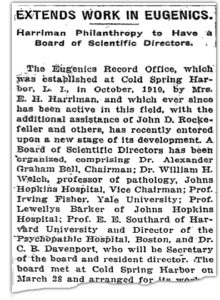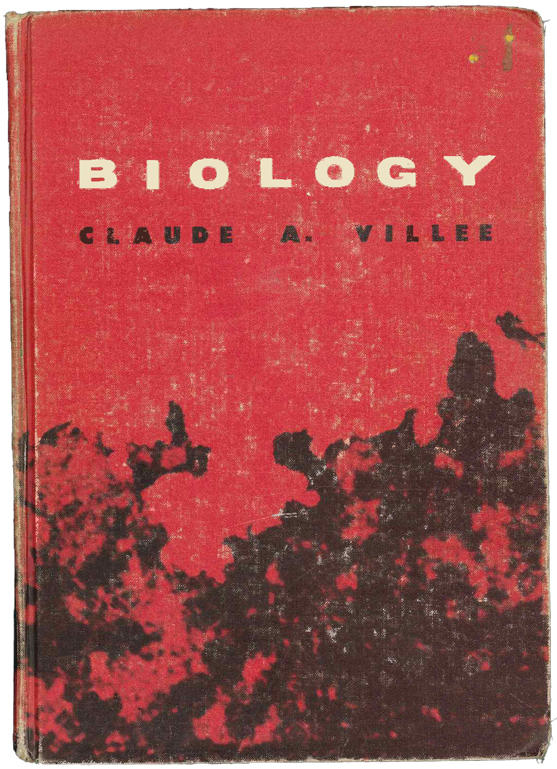August 7, 2011
During the first decades of the twentieth century, WASP elites in the U.S. got themselves into quite a tizzy about sex and race. Metaphysical threats, like the death of “virgin forests,” the “darkening tide” of immigration and the dreaded “white plague” of Tuberculosis, combined with economic threats, like the new permanent income tax, to create a culture open to and fully capable of funding the promotion of public policies and “scientific” solutions that promised to freeze the status quo. Chief among these solutions was the “science” of eugenics.
Eugenics, with some forced sterilization laws here, a few anti-miscegenation laws there, was pitched as a kind of a cure-all for society’s ills, a permanent solution to the problems of alcoholism, pauperism, venereal disease, sexual licentiousness and the general problem of numbers.

March 30, 1913 announcement of the establishment of a Board of Scientific Directors for the Eugenics Record Office at Cold Spring Harbor. ©The New York Times.
Several well-publicized studies of female college graduates indicated that fertility among upper class whites had fallen below replacement levels. Democracy can be a drag when one is in the minority.
In the teens, eugenics proved a smart path to patronage. According to Daniel J. Kevles, author of In the In the Name of Eugenics, “the science of human biological improvement provided an avenue to public standing and usefulness.” Charles Davenport’s success in securing a major donation from Mary Harriman, widow of railroad baron E. H. Harriman, to fund the Eugenics Record Office at Cold Spring Harbor demonstrated to other researchers and academics how they too might cash in.
Given the hot enthusiasm for the topic, particularly in the years leading up to World War I, it is no real surprise that biology textbook authors got in on the action. But the fact that they stayed on board for the next six decades, is, well, kind of scary!
Eugenics made its first appearance in a American biology textbook in 1914 … and then stumbled on in high school textbooks into the 1960s, and in college textbooks into the 1970s!
This fact is a little hard to fathom. After all, as historian Phillip Pauly notes, interest in eugenics among scientists had waned by the 1920s as the topic turned out to be a dry well for research. By the mid-1930s, most of the public began to flee when the ideology began to more obviously reek of racism and nativism. However, while most accounts say enthusiasm for eugenics evaporated by the 1940s (the Eugenics Record Office closed in 1944), even the horrors of Nazi Germany did not give rise to a mob strong enough to take this zombie from the classroom.
Let’s follow our monster’s march through the graveyard of textbooks and see what we can learn.
It’s Alive!
In 1914, college textbook author James Francis Abbott gave students their first small jolt. In Elementary Principles of General Biology, Abbott wrote, “so far as statistics may be depended upon, it would seem that the proportion of defectives, comprising all sorts of persons who, on account of physical, moral, or mental abnormalities, are a burden to society, is steadily and rapidly increasing” (241). Writing the same year, high school textbook author George W. Hunter was less tentative. In A Civic Biology, also published in 1914 and famous for being the textbook at the center of the Scopes trial, Hunter compared the “sexually immoral,” “drunkards,” “epileptics” and the “feeble-minded” to parasites, and stated in a frequently-quoted passage, “if such people were lower animals, we would probably kill them off to prevent them from spreading” (263).
Other high school texts from the period, particularly other texts which built upon the economic model pioneered by Hunter, like Clifton Hodge’s Civic Biology (1918), were nearly as harsh. Eugenic rhetoric reached it apotheosis in William Atwood’s Civic and Economic Biology (1922). In that high school text, Atwood offered the following: “One of the reasons why Greece, Rome, and other great nations of antiquity perished is that they violated the principles of eugenics” (337).
Though eugenics had its critics, 1914 through 1925 were heady years for the ideology, as socialists, capitalists, social workers, social scientists, “birth controllers” and purity advocates all found political utility in the idea. (See related article.)
The Post-Scopes Divide
A divide began to open between college texts and high school texts in the years after the Scopes trial in 1925. While Hunter continued along his dark deterministic path in New Civic Biology (1926), other high school textbook authors adopted a slightly milder tone. This appears due to two factors: First, high school authors were forced by their publishers to respond to anti-evolution sentiment. And as evolution went in these early texts, so went eugenics. Second, the very anthropocentric economic biology curriculum – which positioned the natural world as a wild thing that needed to be tamed and a set of resources that could be exploited for the benefit of humans – began to lose favor relative to the less human-centric phylogenetic and unity of life textbooks, represented respectively by Turman Moon’s Biology for Beginners (1921) and Alfred Kinsey’s An Introduction to Biology (1926). Naturally, the less anthropocentric a textbook, the less emphasis it placed on eugenics.
But even as high school textbook authors pulled back from the eugenic precipice, many college textbook authors went full Thelma and Louise.
Through the 20s and into the later 30s, many (actually most) college textbook authors pumped eugenics as if the topic was fresh and unproblematic. Leonas Lancelot Burlingame’s 1922 text, General Biology, closed with this claim: “It is clear … that the sooner serious general attention is paid to racial betterment through eugenics the better it will be for mankind, both in the near and long distant future” (554). Burlingame set the stage, and not needing to respond to school boards or squeamish parents, college textbook authors were free to wander wherever they wanted.
In 1933, Grace White seconded Atwood’s worry and exposed her WASP racial anxieties when she wrote in General Biology, “The intellectuality of Greece was maintained by the close inbreeding among its favored classes, as was also the political power of Rome. As soon as foreign marriages were sanctioned, and aliens and slaves were admitted to citizenship, the population became mongrelized, and its intellectually declined” (282). And Frank Covert Jean structured the entire narrative of his 1934 textbook, Man and the Nature of His Biological World, so that it led to a frightening eugenic climax.
Going to Extremes
This is not to say the opinions of biology textbook authors were unanimous. As early as 1922, Lorande Loss Woodruff soft-pedaled eugenics in his very popular college textbook, Foundations of Biology. By the mid-1930s, a few more liberal authors began to channel Franz Boas and question the racial assumptions embedded within eugenic ideology. High school textbook authors Ella Thea Smith in Exploring Biology (1938, see related story) and Elsbeth Krober and Walter Wolff in Adventures with Living Things (also 1938, see related story), directly challenged eugenic conventions. In 1942, Gairdner Moment in General Biology for College pushed hard against eugenic prejudice, and in 1944, Benjamin Gruenberg in Biology and Man became the first author in more than a generation to exclude the topic from a text.
Tellingly, neither Moment’s or Gruenberg’s textbooks made much of a dent in the market. Gruenberg’s disappeared after just one edition while Moment’s saw only two. Still, the trendline pointed downward. The number of words devoted to the topic of eugenics shrunk dramatically in high school textbooks through the 40s. By the later 1950s, most high school textbook authors were erasing it entirely. With the exception of James Otto’s Modern Biology in 1960 and 1963, no high school textbook published after 1957 discussed the topic. (See related article.)
The Thing That Wouldn’t Die
However, college textbook authors had a much harder time giving up on eugenics. Shockingly, unlike their high school counterparts, college textbooks grew more eugenic in the years right after World War II. (See related articles here and here.) However, after a brief post-war bump, by the later 1950s the word ‘eugenics’ began to disappear from college texts too … that is, with the exception of one. Probably the most popular one.
The End?
As late as the fifth edition of Biology (originally, Biology: The Human Approach), published in 1967, Harvard professor Claude A. Villee was still preaching the old, and I mean old, eugenic creed. In 1967, Villee was still claiming, as Abbott had in 1914, that, “the average intelligence of the population is decreasing generation to generation” due to differential reproduction. In 1967, Villee was still echoing Hunter, writing, “the mentally defective contribute little to society and many are burdens as inmates of institutions.” In 1967, Villee was still using “idiot,” “imbecile,” “moron” and “feeble-minded” as clinical terms. And in 1967, during the “Summer of Love,” Villee, of Harvard, still thought it not all that problematic to suggest that the United States should sterilize 2% of its population, or 4,000,000 million people. Click here to read it for yourself.
I’m going to guess that the topic of eugenics finally disappeared from biology textbooks for good in the 1970s. (Was I right? See Database Update: Eugenics in College Textbooks.) But really, isn’t it a bit surprising to learn just how late into the century eugenics stumbled? As a research topic it may have been “moribund” by the 1920s, as Steven Selden states. Yet it walked as a zombie into classrooms for at least a half century more, feasting on the brains of students who are still working today as doctors, psychologists and teachers.
Let us hope that the lessons of the Civil Rights era provided adequate inoculation.
See – Database: Eugenics in College Biology Textbooks
See – Database: Eugenics in High School Biology Textbooks
REFERENCES
Kevles, Daniel J 1985. In the Name of Eugenics: Genetics and the Uses of Human Heredity. Berkeley: University of California Press.
Pauly, Philip J. 2000. Biologists and the Promise of American Life. Princeton: Princeton University Press.
Selden, Steven. 1999. Inheriting Shame: The Story of Eugenics and Racism in America. New York: Teachers College Press.


hojrid
weodp2